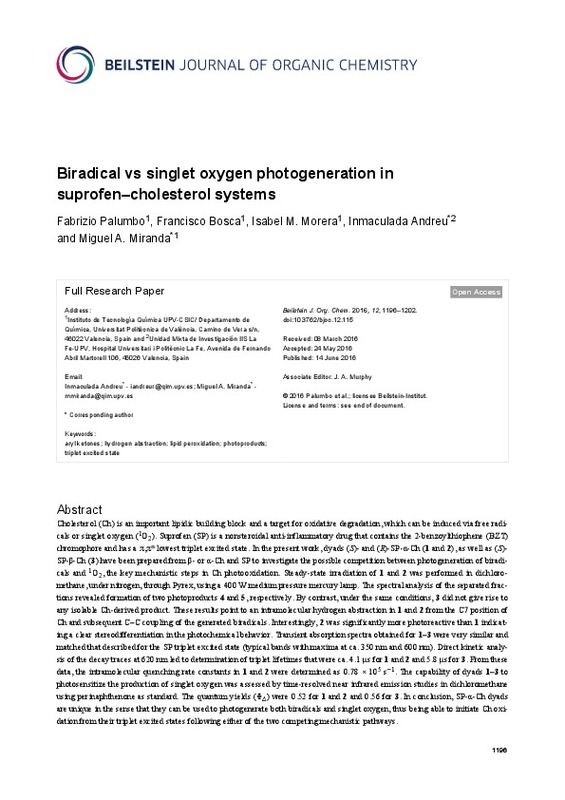JavaScript is disabled for your browser. Some features of this site may not work without it.
Buscar en RiuNet
Listar
Mi cuenta
Estadísticas
Ayuda RiuNet
Admin. UPV
Biradical vs singlet oxygen photogeneration in suprofen cholesterol systems
Mostrar el registro sencillo del ítem
Ficheros en el ítem
| dc.contributor.author | Palumbo, Fabrizio
|
es_ES |
| dc.contributor.author | Bosca Mayans, Francisco
|
es_ES |
| dc.contributor.author | Morera Bertomeu, Isabel María
|
es_ES |
| dc.contributor.author | Andreu Ros, María Inmaculada
|
es_ES |
| dc.contributor.author | Miranda Alonso, Miguel Ángel
|
es_ES |
| dc.date.accessioned | 2016-10-31T12:35:21Z | |
| dc.date.available | 2016-10-31T12:35:21Z | |
| dc.date.issued | 2016-06-14 | |
| dc.identifier.issn | 1860-5397 | |
| dc.identifier.uri | http://hdl.handle.net/10251/72997 | |
| dc.description.abstract | Cholesterol (Ch) is an important lipidic building block and a target for oxidative degradation, which can be induced via free radicals or singlet oxygen (1O2). Suprofen (SP) is a nonsteroidal anti-inflammatory drug that contains the 2-benzoylthiophene (BZT) chromophore and has a π,π* lowest triplet excited state. In the present work, dyads (S)- and (R)-SP-α-Ch (1 and 2), as well as (S)-SP-β-Ch (3) have been prepared from β- or α-Ch and SP to investigate the possible competition between photogeneration of biradicals and 1O2, the key mechanistic steps in Ch photooxidation. Steady-state irradiation of 1 and 2 was performed in dichloromethane, under nitrogen, through Pyrex, using a 400 W medium pressure mercury lamp. The spectral analysis of the separated fractions revealed formation of two photoproducts 4 and 5, respectively. By contrast, under the same conditions, 3 did not give rise to any isolable Ch-derived product. These results point to an intramolecular hydrogen abstraction in 1 and 2 from the C7 position of Ch and subsequent C C coupling of the generated biradicals. Interestingly, 2 was significantly more photoreactive than 1 indicating a clear stereodifferentiation in the photochemical behavior. Transient absorption spectra obtained for 1 3 were very similar and matched that described for the SP triplet excited state (typical bands with maxima at ca. 350 nm and 600 nm). Direct kinetic analysis of the decay traces at 620 nm led to determination of triplet lifetimes that were ca. 4.1 μs for 1 and 2 and 5.8 μs for 3. From these data, the intramolecular quenching rate constants in 1 and 2 were determined as 0.78 × 105 s−1. The capability of dyads 1 3 to photosensitize the production of singlet oxygen was assessed by time-resolved near infrared emission studies in dichloromethane using perinaphthenone as standard. The quantum yields (ΦΔ) were 0.52 for 1 and 2 and 0.56 for 3. In conclusion, SP-α-Ch dyads are unique in the sense that they can be used to photogenerate both biradicals and singlet oxygen, thus being able to initiate Ch oxidation from their triplet excited states following either of the two competing mechanistic pathways. | es_ES |
| dc.description.sponsorship | Financial support from the Generalitat Valenciana (Prometeo Program), the Spanish Government (CTQ2014-54729-C2-2-P and FPU fellowship for F.P.) and the Carlos III Institute of Health (Grant RIRAAF, RETICS program and Miguel Servet Contract CP11/00154 for I. A.) is gratefully acknowledged. | en_EN |
| dc.language | Inglés | es_ES |
| dc.publisher | Beilstein-Institut | es_ES |
| dc.relation.ispartof | Beilstein Journal of Organic Chemistry | es_ES |
| dc.rights | Reconocimiento (by) | es_ES |
| dc.subject | Aryl ketones | es_ES |
| dc.subject | Hydrogen abstraction | es_ES |
| dc.subject | Lipid peroxidation | es_ES |
| dc.subject | Photoproducts | es_ES |
| dc.subject | Triplet excited state | es_ES |
| dc.subject.classification | QUIMICA ORGANICA | es_ES |
| dc.title | Biradical vs singlet oxygen photogeneration in suprofen cholesterol systems | es_ES |
| dc.type | Artículo | es_ES |
| dc.identifier.doi | 10.3762/bjoc.12.115 | |
| dc.relation.projectID | info:eu-repo/grantAgreement/MINECO//CTQ2014-54729-C2-2-P/ES/DISEÑO DE NUEVAS PRODROGAS ANTICANCERIGENAS FOTOACTIVABLES/ | es_ES |
| dc.relation.projectID | info:eu-repo/grantAgreement/MICINN//CP11%2F00154/ES/CP11%2F00154/ | es_ES |
| dc.rights.accessRights | Abierto | es_ES |
| dc.contributor.affiliation | Universitat Politècnica de València. Escuela Técnica Superior de Ingenieros Industriales - Escola Tècnica Superior d'Enginyers Industrials | es_ES |
| dc.contributor.affiliation | Universitat Politècnica de València. Instituto Universitario Mixto de Tecnología Química - Institut Universitari Mixt de Tecnologia Química | es_ES |
| dc.description.bibliographicCitation | Palumbo, F.; Bosca Mayans, F.; Morera Bertomeu, IM.; Andreu Ros, MI.; Miranda Alonso, MÁ. (2016). Biradical vs singlet oxygen photogeneration in suprofen cholesterol systems. Beilstein Journal of Organic Chemistry. 12:1196-1202. https://doi.org/10.3762/bjoc.12.115 | es_ES |
| dc.description.accrualMethod | S | es_ES |
| dc.relation.publisherversion | http://dx.doi. org/10.3762/bjoc.12.115 | es_ES |
| dc.description.upvformatpinicio | 1196 | es_ES |
| dc.description.upvformatpfin | 1202 | es_ES |
| dc.type.version | info:eu-repo/semantics/publishedVersion | es_ES |
| dc.description.volume | 12 | es_ES |
| dc.relation.senia | 319372 | es_ES |
| dc.identifier.pmid | 27559371 | en_EN |
| dc.identifier.pmcid | PMC4979683 | en_EN |
| dc.contributor.funder | Ministerio de Ciencia e Innovación | es_ES |
| dc.contributor.funder | Ministerio de Economía y Competitividad | es_ES |
| dc.contributor.funder | Generalitat Valenciana | es_ES |
| dc.contributor.funder | Instituto de Salud Carlos III | es_ES |








